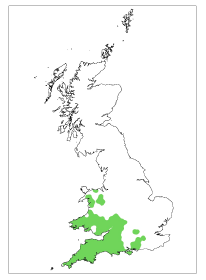Britain’s population of around 13,000 greater horseshoe bats (Rhinolophus ferrumequinum) was until recently restricted to south and west Wales and south-west England.
As its population has started to recover, individuals and small colonies have been recorded as far away as North Wales and Sussex. Unlike the lesser horseshoe bat, it is absent from Ireland.
Our work
Vincent Wildlife Trust (VWT) has sought to conserve horseshoe bats through:
- the establishment of bat roost reserves in both Britain and Ireland;
- ongoing monitoring of the populations of horseshoe bats in key roosts;
- carrying out work to secure, maintain and improve both hibernation and summer roosts;
- major studies of the roosting and foraging ecology of the species;
- undertaking a major assessment of the foraging areas and commuting routes surrounding key greater horseshoe bat breeding roosts;
- surveys of buildings in south-west England, the west Midlands, Wales and Ireland for undiscovered horseshoe bat roosts;
- a study of the effects of Ivermectin, a chemical cattle treatment, which reduces the number of insects in cowpat communities on which greater horseshoe bats are known to feed;
- training workshops based around its reserves to inform ecological consultants and Statutory Nature Conservation Organisations (SNCO) staff about appropriate mitigation measures for the species;
- supporting a PhD examining how landscape connectivity, habitat suitability and land management influence the distribution and movement of the greater horseshoe bat.
Useful Links
- Read about our research on the impact of greater horseshoe bat presence on lesser horseshoe bat roosts
- Learn more about the greater horseshoe bat via our Resources
- Learn about the PhD study on the greater horseshoe bat in our PhD student blog
- Read about our bat reserves in Britain and Ireland
Photo: Greater horseshoe bat ©Frank Greenaway
Distribution map: ©The Mammal Society
